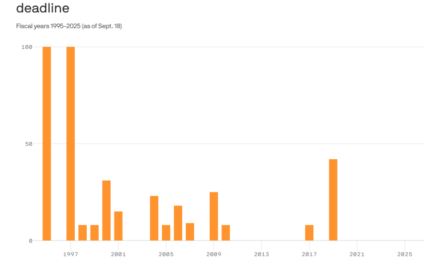We support our Publishers and Content Creators. You can view this story on their website by CLICKING HERE.
As the nation continues to process the wreckage and tragic death toll from Hurricane Helene, yet another storm — Hurricane Milton — is set to make landfall at midweek.
As it stands, Homeland Security Secretary Mayorkas has said FEMA doesn’t have enough funding to last through hurricane season.
BY THE NUMBERS
The agency’s disaster relief fund had a $6 billion deficit as of a July 31 Office of Inspector General report.
Last October, President Biden requested $23.5 billion in disaster aid funds, including $9 billion for FEMA. Congress ignored it— they instead focused on aid to Ukraine, Israel, Taiwan and other matters.
In June, Biden requested almost $4 billion more, mostly to rebuild Baltimore’s collapsed Francis Scott Key bridge, is also included $700 million for the Department of Housing and Urban Development to finance long-term rebuilding needs from previous disasters.
BILLIONS TIED UP IN OLD PROJECTS
But part of the shortfall is due to procedures and bookkeeping inside FEMA. The agency has $8.3 billion in “unliquidated obligations” set aside to help victims of storms from before 2012! That’s according to a Homeland Security Office of Inspector General report titled “FEMA’s Inadequate Oversight Led to Delays in Closing Out Declared Disasters.”
This is money that FEMA has promised to spend, but it’s unclear when or if it will actually help American families. That’s a dozen years ago!
Because FEMA failed to follow procedures, that money is stuck in purgatory instead of back in the Disaster Relief Fund where it could help immediately.
HOW WE GOT HERE
Star Jet Rollercoaster, along the boardwalk in Seaside Heights, New Jersey, damaged by Hurrricane Sandy (Anthony Quintano; Feb. 24, 2013).
Money can be obligated for long-term projects as part of FEMA’s procedures…But not for this long and not without a good reason.
The agency is required to use grants by a deadline. If the deadline is extended, FEMA officials must give a detailed written justification. But FEMA has recently extended deadlines by up to 16 years for $7 billion of grants, sometimes without explanation.
For example, FEMA set aside billions to help the Northeast recover from Hurricane Sandy in 2012. The money was supposed to be used by October 2016, but FEMA extended the deadline to September 2026. $4.5 billion of it was still unused as of last year and is unavailable for victims of this year’s storms.
FROM THE IG REPORT: The Department of Homeland Security Inspector General found that the extensions are awarded based on “subjective” criteria. “As a result, the potential risk for fraud, waste, and abuse increases the longer a program remains open.”
THE COVID RESPONSE STRIKES AGAIN
On top of this budgeting issue for its disaster relief funds, FEMA also greatly underestimated how much money it would need to spend on the Covid-19 pandemic. It has spent $103.6 billion on the pandemic response, and that number is expected to rise to $171.6 billion by August 2026!
As a result, the GAO reported that the agency had not requested enough money from Congress to carry out all of its operations over the last few years.
Yet FEMA continues to approve new Covid-related expenses — including funerals — despite the fact that the public health emergency officially ended in May 2023.
BACK TO CONGRESS FOR MORE CASH
President Biden has pledged to “surge” equipment, supplies, personnel and other needed resources into the states hit hard by the storm. FEMA has sent over 4,500 people to support the states impacted by Hurricane Helene.
Congress, however, is in a recess until after the November election!
Before leaving Washington at the end of September, lawmakers passed a stopgap funding measure to fund the government. It included a provision to allow FEMA to tap into about $20 billion in disaster relief funds beginning Oct. 1, the start of the new fiscal year.
BUT…about $6 billion of that is expected to be used to address a host of pent-up demands for disaster recovery efforts, from flooding in Vermont to wildfires in Hawaii.
In August, FEMA was forced to put longer-term projects on hold for “immediate needs funding” status, using available funds only for the highest-priority “lifesaving and life-sustaining” activities.
It paused 650 projects that were not deemed essential for “life-saving services.” The same thing happened in October 2023 and seven other times since 2001.
WHAT NEXT?
Federal Emergency Management Agency building (Ajay Shuresh; June 21, 2024).
FEMA could decide to keep prioritizing only immediate needs, even after receiving its $20 billion. That would mean further delays in addressing longstanding disaster relief needs.
So not only does it appear that FEMA needs more funding, it also needs better practices and a longer-term solution to its project backlog.
Otherwise, we’re bound to keep earmarking money, leaving it tied up in red tape, and then asking Congress repeatedly for more emergency funding.
FURTHER READING
$8.3 Billion of Disaster Funds Stuck in Purgatory | Waste of the Day | Jeremy Portnoy, OpenTheBooks.com | RealClearInvestigations
Disaster Relief Fund in Danger After $104 Billion in COVID Spending | Waste of the Day | Adam Andrzejewski, OpenTheBooks.com | RealClearInvestigations
What If I Told You FEMA Had $8B Sitting in Bank Accounts that the Agency Still Hasn’t Used? | The Breanna Morello Show | X
“FEMA’s Inadequate Oversight Led to Delays in Closing Out Declared Disasters.” | Office of the Inspector General | Department of Homeland Security

 Conservative
Conservative  Search
Search Trending
Trending Current News
Current News 





